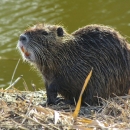States
AlaskaEnvironmental Impact Statement (EIS)
The U.S. Fish and Wildlife Service (FWS) intends to prepare an Environmental Impact Statement (EIS) for a proposed project to eradicate invasive rats from four islands (Amchitka, Attu, Great Sitkin, and Kiska Islands) located in the Alaska Maritime National Wildlife Refuge (Refuge). The purpose of the proposed action is to eliminate the impacts of invasive rats on native species and restore natural island ecosystems on Great Sitkin, Amchitka, Kiska, and Attu Islands. The proposed action is needed because invasive rats on these islands have negatively impacted native wildlife populations and altered natural ecosystem functions.
Impacts of Non-Native Rats
The Problem
Although islands account for just 6% of the world's landmass, they are home to approximately 20% of the world's bird and plant species. Since the 1700’s, shipwrecks, trappers, homesteaders, military, and other government agencies have accidentally and intentionally brought new non-native species to the Aleutian Islands. Despite over 60 years of invasive species invasive species
An invasive species is any plant or animal that has spread or been introduced into a new area where they are, or could, cause harm to the environment, economy, or human, animal, or plant health. Their unwelcome presence can destroy ecosystems and cost millions of dollars.
Learn more about invasive species management, non-native rats remain on at least 12 large islands in the Aleutian Island archipelago, including the islands of Great Sitkin, Kiska, Amchitka, and Attu Islands.
The diversity and numbers of breeding birds are conspicuously low on islands with established populations of nonnative rats and seabirds are one of the most threatened bird groups on the planet, with approximately 30% at risk of extinction from invasive species impacts. For example, on Kiska Island, carcasses of least auklets and crested auklets were found in rat food caches. Research also suggests that rat predation on nesting marine birds such as glaucous-winged gulls and black oystercatchers might also indirectly alter intertidal ecological community structure.
Eradication Works
In 2008, the Refuge and partner organizations demonstrated Norway rats could be successfully eradicated from Hawadax Island, and this resulted in significant recoveries of terrestrial native birds and shorebirds, and the initial recolonization or recovery of native marine birds 5 years after eradication. Intertidal ecosystem recovery was also documented 11 years post-eradication.
EIS Process
The National Environmental Policy Act (NEPA) – EIS Process requires federal agencies to incorporate environmental considerations into their planning and decision making. It also requires federal agencies to undertake an assessment of the environmental impacts of and alternatives to their proposed major federal actions prior to making any decisions.
FWS intends to eradicate invasive rats from four islands in the Refuge. The islands are remote, and eradication efforts would be undertaken on one single island at a time, with years between efforts on each island. FWS is currently considering four preliminary alternatives and the no-action alternative. The Service will identify a preferred alternative in the final EIS. The following alternatives are preliminary and may be revised based on public input and internal considerations.
- Alternative 1: The no-action alternative, in which nonnative rats remain on islands.
- Alternative 2: This alternative proposes rat eradication primarily using bait pellets containing the rodenticide brodifacoum.
- Alternative 3: This alternative proposes rat eradication primarily using bait pellets containing the rodenticide diphacinone.
- Alternative 4: This alternative analyzes rat eradication using emerging genetic biocontrol technology to limit propagation or survival.
- Alternative 5: This alternative analyzes rat eradication primarily using bait pellets containing the rodenticide norbormide.
General EIS Timeline
The general timeline of the project, which includes opportunities for public input, review and comment, is outlined below.In the event of a lapse in appropriations, public meetings may be rescheduled. This webpage will not be updated during a government shutdown.
| Month and Year | EIS Project Milestones |
|---|---|
| September 2024 | Notice of Intent to prepare an EIS; public scoping begins |
| October 2024 | Public scoping meetings (minimum 30-day review period) |
| November 7, 2024 | Public scoping period concludes |
| November/December 2024 | Analyze comments and prepare scoping summary report |
| Winter 2024 - Winter 2025 | Gather data, refine alternatives, analyze impacts and prepare the Draft EIS |
| Early Spring 2026 | Draft EIS available for public comment (minimum 30-day review period) |
| Fall 2026 | Final EIS published |
| Winter 2026 | Record of Decision |
Meeting Notices
The U.S. Fish and Wildlife Service hosted an Agency/Public Communication Session in Anchorage, Alaska on October 9, 2024. The next meeting is tentatively scheduled for Spring 2026.
Public Comments
The public scoping period began on September 23, 2024 and ended on November 7, 2024. USFWS invited comments from the public and local, State, Tribal, and Federal agencies on the scope of the analysis, potential alternatives, and identification of relevant information, studies, and analyses. Comments received are being reviewed and considered, and substantive comments will be incorporated while writing the EIS.
View the Notice of Intent at https://www.regulations.gov . Search for Docket No. FWS-R7-NWRS-2024-0032.
Contacts
Contact rateradication_AKMNWR@fws.gov for further information.
- Stacey Buckelew, Island Invasive Strike Team Biologist, Fisheries and Ecological Services
- Jeff Williams, Refuge Manager, Acting, Alaska Maritime National Wildlife Refuge
- Lauren Flynn, Wildlife Refuge Specialist, National Wildlife Refuge System
- Adrienne McGill, Visitor Services Manager, Alaska Maritime National Wildlife Refuge
Partners
Cooperating Agencies
Key Collaborators
- Aleutian Pribilof Islands Association
- Native Village of Atka
- Atux Forever
Learn more about the full vision:








